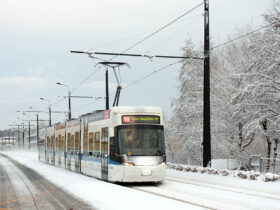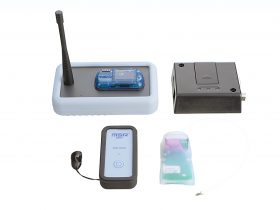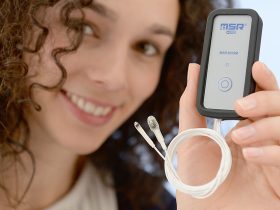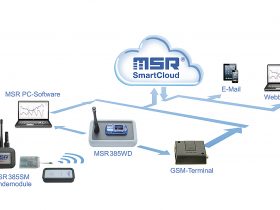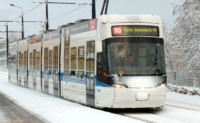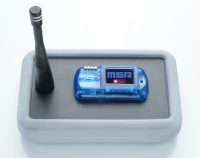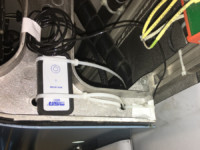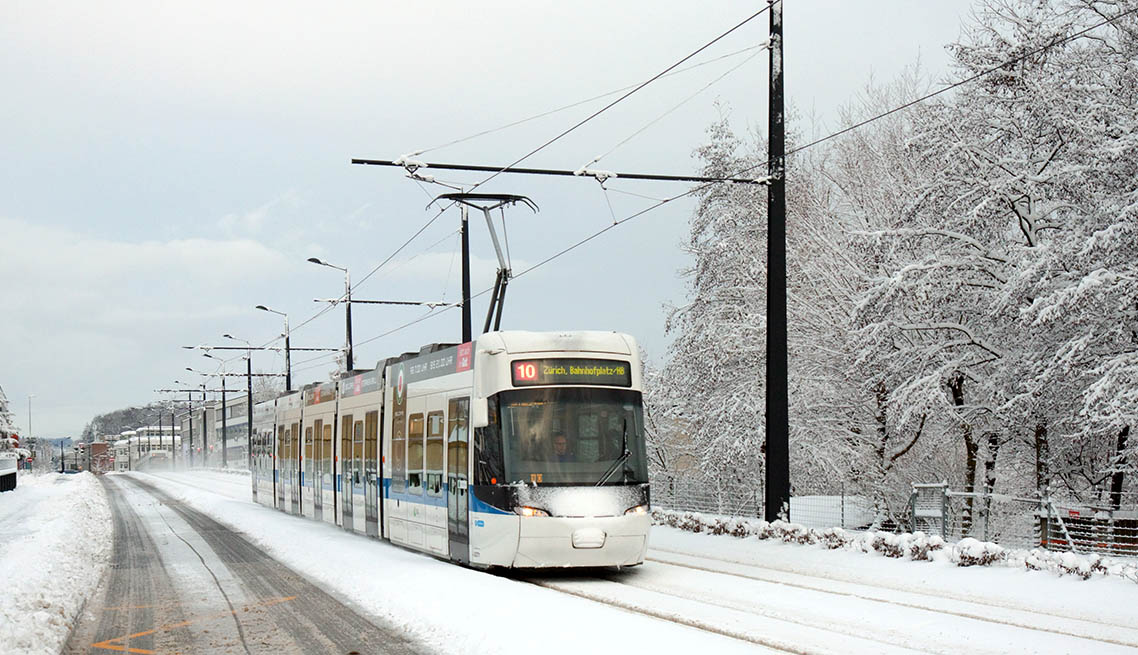
Wireless Data Loggers Support Climatic Measurements in Trams
The use of MSR385WD data loggers can help to save energy
Whether bus, tram or train: By reducing the temperature in the passenger compartment by just a few degrees, we can significantly lower the heating costs in local public transport. In order to substantiate this scientifically, the University of Applied Sciences Rapperswil is determining the electricity requirement for heating the passenger compartment – by means of small wireless data loggers of the type MSR385WD.
Author: Sven Strebel, research assistant in the ‘Renewable Energies’ research group, Zurich University of Applied Sciences. The article below was published in the German ‘messtec drives Automation’ trade journal, Sonderheft traffic (traffic special edition) 03/2018.
Electric trains can save electricity – both through energy-efficient vehicles and facilities (for example track systems, security systems, railway stations) and through innovative train operation, using modern traction systems. The modernisation of the vehicle fleet, the recuperation of braking energy and energy-efficient driving reduce the energy consumption. Whilst improvements in the efficiency of traction power have been implemented in recent years, the saving potential for the supply of compartment heating, in particular for existing vehicle fleets, is not yet exhausted.
Great savings potential for electric local passenger transport
In public transport, passengers spend a relatively short period of time inside the vehicle; therefore we can assume that they keep their clothing on that is adapted to the weather. Great differences in temperature between the indoor and outdoor climate are therefore likely to have a negative impact on the thermal comfort of the passengers, while resulting in a high degree of energy demand. This is particularly the case when, in order to supply the required compartment heating, electrically powered vehicles in public transport use conventional resistance heaters which have not been used for some time in buildings and flats (electric “night storage heaters”) for reasons of efficiency. In addition, due to their relatively compact design, local public transport vehicles have a relatively poor insulation value when compared to buildings; therefore a high thermal output is required to heat the passenger compartment.
By lowering the indoor temperature in trams, it might be possible to save energy without a major loss of comfort, which is in part due to the short duration of stay. This is crucial to the extent that different studies relating to this show that the energy requirement for heating electric vehicles accounts for between 10 and 50 percent of the overall energy demand.
Within the scope of a Master’s thesis for the degree course MSE (Master of Sciences in Engineering) at the University of Applied Sciences Rapperswil, the specific heating energy requirement of a «Cobra Tram» of the Verkehrsbetriebe Zürich (public transport operator in Zurich) was examined during winter operation. To this end, the electricity requirement for heating the passenger compartment during regular tram operation, the solar heat input through the windows, the waste heat from passengers and devices, as well as the difference in temperature between the passenger compartment and the environment was examined.
Data logger with wireless sensors for wireless climatic measurement
For measuring the indoor climate, a compromise had to be found in order to measure the air temperature of the relevant areas (seating and standing area), yet attach the sensors in such a way that they can be neither manipulated nor removed during operation. Furthermore, the different areas in the interior of the tram (foot and head section, proximity to door, etc.) as well as the five compartment sections must be taken into consideration; therefore the measuring points have to be distributed across the entire vehicle.
Small sensor modules and data loggers, which are manufactured by the Swiss measuring technology company MSR Electronics GmbH and which are already proving successful in a range of applications in the industry, traffic, logistics and machine segment, have contributed significantly to the measurements required for this.
As wiring traditional temperature sensors in the interior would have involved a huge amount of time and effort, wireless temperature sensors with a transmitter module of the type MSR385SM and a wireless data logger of the MSR385WD series produced by this company were used. A total of 20 sensors were distributed across the vehicle; the central wireless data logger was installed in the centre of the tram and, by means of its mobile network router, the data was uploaded to the MSR cloud. The sensors were self-sufficiently supplied with power by batteries. To supplement the measurements, an air temperature sensor and several solar radiation sensors were attached to the roof of the vehicle in order to record the outdoor temperature and the solar radiation impacting on the window surfaces.
The small size of the temperature sensor module, the sufficiently long duration of autonomous operation with the installed battery and the easy configuration and monitoring of the measured values by means of the cloud solution by MSR were ultimately the deciding criteria in favour of the all-in-one system offered by this company.
From sensor module to the cloud
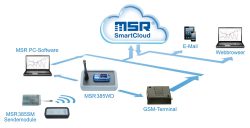 The MSR385WD wireless data logger can be used to permanently record temperature, humidity and pressure at different measuring points and at operating temperatures ranging from -20 °C to +125 °C and to monitor them, wherever you are. These features make this logger the ideal choice for the task in the tram. The data logger has an integrated 868 MHz ISM band receiver module, which receives data from up to ten MSR385SM sensor transmitter modules and records them. These transmitter modules record temperature profiles, humidity and pressure by means of sensors and send the measured values to the data logger in the ISM band, which can be used without a licence. Depending on the frequency of the measurements and radio transmissions, the power supply to the transmitter modules is warranted for up to five years. Due to their thermal resistance, the transmitter modules – depending on the type of case – facilitate metrological applications even at high operating temperatures of up to +125 °C; however, this was not required in this case. The measuring and transmission intervals of the transmitter modules can be adjusted as follows: 1 s, 10 s, 1 min, 15 min, 1 h. Depending on the type of case selected, the transmitter modules are supplied with power either by means of a rechargeable 260 mAh lithium-polymer battery or an 800 mAh Li-SOCl2 battery. The optimised power management ensures that – depending on the frequency of measurements and radio transmissions – the power supply to the miniature transmitter modules is warranted for up to five years. Equipped with the smallest type of case, such a compact transmitter module weighs approximately 25 g and measures just 35 x 55 x 25 mm externally. Therefore, it can be positioned even in inaccessible locations, as in this case. An integrated flash memory safeguards the data security in the event of a power failure.
The MSR385WD wireless data logger can be used to permanently record temperature, humidity and pressure at different measuring points and at operating temperatures ranging from -20 °C to +125 °C and to monitor them, wherever you are. These features make this logger the ideal choice for the task in the tram. The data logger has an integrated 868 MHz ISM band receiver module, which receives data from up to ten MSR385SM sensor transmitter modules and records them. These transmitter modules record temperature profiles, humidity and pressure by means of sensors and send the measured values to the data logger in the ISM band, which can be used without a licence. Depending on the frequency of the measurements and radio transmissions, the power supply to the transmitter modules is warranted for up to five years. Due to their thermal resistance, the transmitter modules – depending on the type of case – facilitate metrological applications even at high operating temperatures of up to +125 °C; however, this was not required in this case. The measuring and transmission intervals of the transmitter modules can be adjusted as follows: 1 s, 10 s, 1 min, 15 min, 1 h. Depending on the type of case selected, the transmitter modules are supplied with power either by means of a rechargeable 260 mAh lithium-polymer battery or an 800 mAh Li-SOCl2 battery. The optimised power management ensures that – depending on the frequency of measurements and radio transmissions – the power supply to the miniature transmitter modules is warranted for up to five years. Equipped with the smallest type of case, such a compact transmitter module weighs approximately 25 g and measures just 35 x 55 x 25 mm externally. Therefore, it can be positioned even in inaccessible locations, as in this case. An integrated flash memory safeguards the data security in the event of a power failure.
The measurement trends of the transmitter modules recorded by the data logger can be read out via a USB interface and processed further using the MSR PC software for data analysis purposes. In addition, a GSM module facilitates the connection of the MSR385WD to the «MSR SmartCloud», a web-based service for mobile data monitoring by MSR Electronics. The wireless data logger is equipped with a colour OLED display to instantly view the data. The high screen resolution facilitates easy reading of measured values, even in total darkness and from virtually any viewing angle.
Meaningful results
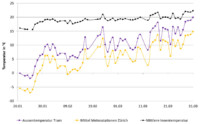 The primary purpose of the measurements was to derive energy-saving potential. In this context, the chart shown here illustrates the development of the indoor temperature of the tram, the outdoor air temperature and the average air temperature above the metropolitan area of Zurich, recorded by the sensors and loggers across the investigation period of more than two months.
The primary purpose of the measurements was to derive energy-saving potential. In this context, the chart shown here illustrates the development of the indoor temperature of the tram, the outdoor air temperature and the average air temperature above the metropolitan area of Zurich, recorded by the sensors and loggers across the investigation period of more than two months.
In addition, another chart shows the heat input from the different heat sources (heating, solar input through windows, etc.) per day during the investigation period. Please note that the data is not standardised and depends on the period of use of the tram on the respective day. On days with a very low heat input (< 50 kWh/day), the vehicle is not in proper operation. This representation shows that the largest percentage of heat input is due to the electric heating. Depending on the use of the tram and the ambient temperature, it measures between 100 and 800 kWh per day per tram. By way of comparison, the average electricity requirement of a typical 2-person household is around 4500 kWh per year.
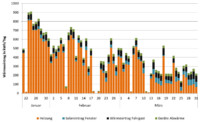 Based on these climatic measurements, the annual heating energy requirement can be estimated at approximately 72 MWh for a Cobra Tram. A reduction of the indoor temperature by 2 degrees Celsius would already accomplish savings of approximately 25 percent. Assuming that the entire electrically operated vehicle fleet of the Verkehrsbetriebe Zürich (public transport operator in Zurich) has the same specific thermal energy requirement, this would result in savings of approximately 3.3 GWh annually. This corresponds to the electricity requirement of around 730 single-family homes. In contrast to other measures, such as the optimisation of the insulation or the installation of more efficient heaters, a reduction of the indoor temperature is a relatively simple measure for reducing the energy requirement, both from a technical and financial perspective.
Based on these climatic measurements, the annual heating energy requirement can be estimated at approximately 72 MWh for a Cobra Tram. A reduction of the indoor temperature by 2 degrees Celsius would already accomplish savings of approximately 25 percent. Assuming that the entire electrically operated vehicle fleet of the Verkehrsbetriebe Zürich (public transport operator in Zurich) has the same specific thermal energy requirement, this would result in savings of approximately 3.3 GWh annually. This corresponds to the electricity requirement of around 730 single-family homes. In contrast to other measures, such as the optimisation of the insulation or the installation of more efficient heaters, a reduction of the indoor temperature is a relatively simple measure for reducing the energy requirement, both from a technical and financial perspective.
These pages might also be of interest to you:
- Configure your own custom MSR385WD variant here…
- Product overview MSR data loggers for climate monitoring
- Wireless data logger MSR385WD monitors temperatur at wind turbine gearboxes in China
- Measurement data from the cloud: MSR385WD wireless data logger measures climate values in state museum
- Stadler Rail: Use of MSR165 data logger for measurements on ride comfort and safety
 Deutsch
Deutsch

